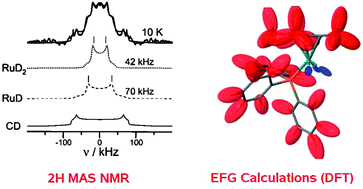DFT 2H quadrupolar coupling constants of ruthenium complexes: a good probe of the coordination of hydrides in conjuction with experiments
Abstract
Transition metal (TM) hydrides are of great interest in chemistry because of their reactivity and their potential as catalysts for hydrogenation reactions. 2H solid-state NMR can be used in order to get information about the local environment of hydrogen atoms, and more particularly the coordination mode of hydrides in such complexes. In this work we will show that it is possible to establish at the level of density functional theory (DFT) a viable methodological strategy that allows the determination of 2H NMR parameters, namely the quadrupolar coupling constant (CQ) respectively the quadrupolar splitting (ΔνQ) and the asymmetry parameter (ηQ). The reliability of the method (B3PW91-DFT) and basis set effects have been first evaluated for simple organic compounds (benzene and fluorene). A good correlation between experimental and theoretical values is systematically obtained if the large basis set cc-pVTZ is used for the computations. 2H NMR properties of five mononuclear ruthenium complexes (namely Cp*RuD3(PPh3), Tp*RuD(THT)2, Tp*RuD(D2)(THT) and Tp*RuD(D2)2 and RuD2(D2)2(PCy3)2) which exhibit different ligands and hydrides involved in different coordination modes (terminal-H or η2-H2), have been calculated and compared to previous experimental data. The results obtained are in excellent agreement with experiments. Although 2H NMR spectra are not always easy to analyze, assistance by quantum chemistry calculations allows unambiguous assignment of the signals of such spectra. As far as experiments can be achieved at very low temperatures in order to avoid dynamic effects, this hybrid theoretical/experimental tool may give useful insights in the context of the characterization of ruthenium surfaces or nanoparticles with solid-state NMR.


 Please wait while we load your content...
Please wait while we load your content...